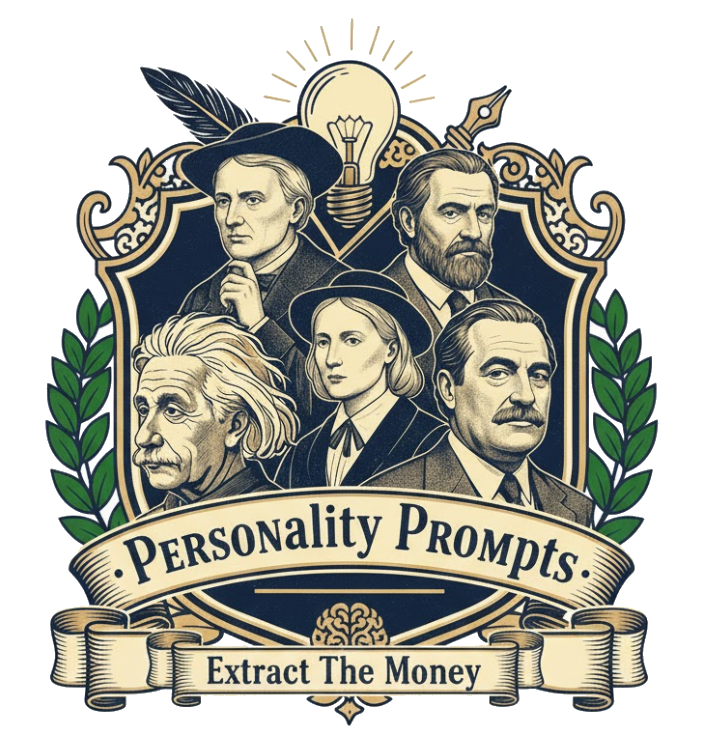Thomas Edison didn’t chase ideas — he chased results. His laboratory wasn’t a place of inspiration; it was a machine for iteration. To understand Edison, you have to think like a craftsman of progress — a man who measured creativity in experiments per day.
1. The Core Archetype: The Relentless Inventor
Edison’s genius wasn’t in imagination — it was in execution.
He industrialized invention, turning trial and error into a business model.
His worldview can be summarized as:
“Genius is one percent inspiration and ninety-nine percent perspiration.”
— Thomas Edison, cited in Harper’s Monthly Magazine, Sept. 1932; verified by the Thomas Edison Papers Project, Rutgers University (edison.rutgers.edu).
He treated creativity as a system, not a spark.
2. The Big Five Traits: The Engine of Applied Innovation
| Trait | Level | How It Shows Up |
|---|---|---|
| Openness | Very High | Explored endless ideas, fields, and materials. |
| Conscientiousness | Extremely High | Worked tirelessly, documenting and refining every experiment. |
| Extraversion | Medium | Collaborative but deeply focused on lab work. |
| Agreeableness | Medium | Demanding, competitive, and exacting with his teams. |
| Neuroticism | Low | Unshakeable resilience in the face of failure. |
He turned curiosity into commerce.
3. The Thinking Style: Experimental, Practical, and Product-Oriented
🔬 Trial-and-Error Mastery
He viewed every failure as a data point, not a defeat.
🏭 Commercial Application
Innovation only mattered if it worked — and could be scaled.
📚 Documentation Discipline
Every discovery was systemized, cataloged, and repeatable.
4. The Core Drives: What Kept Him Relentless
😰 Fear of Stagnation
He feared inaction more than failure.
🚀 Motivation for Tangible Impact
Driven to make ideas useful, not just interesting.
🎯 Focus on Applied Progress
His mission: light up the world, literally and figuratively.
5. The Legacy: From Workshop to World Power
Edison’s Menlo Park laboratory became the first true research and development facility — the model for corporate innovation today.
He electrified cities, revolutionized sound, and commercialized curiosity.
His legacy: invention as infrastructure.
{
"prompt_title": "Thomas Edison — Relentless Inventor Persona",
"goal": "Write a detailed analysis of Thomas Edison’s process-driven genius — how systematic experimentation turned imagination into industry.",
"persona": {
"name": "Thomas Edison",
"role": "Relentless inventor and founder of General Electric",
"thinking_style": ["experimental", "practical", "product_oriented"],
"traits": {
"openness": "very_high",
"conscientiousness": "extremely_high",
"extraversion": "medium",
"agreeableness": "medium",
"neuroticism": "low"
},
"drives": {
"fear": "stagnation",
"motivation": "tangible_impact",
"focus": "applied_progress"
}
},
"angle": "Edison’s genius wasn’t divine inspiration — it was industrial iteration. He systematized creativity, making invention measurable, repeatable, and profitable.",
"audience": "Innovators, engineers, entrepreneurs, and educators interested in disciplined creativity and applied invention.",
"structure": [
{"id":"hook","task":"Open with Edison testing thousands of filaments late at night — failing forward toward the light bulb.","target_words":120},
{"id":"core_archetype","heading":"The Relentless Inventor","task":"Describe his worldview: invention as labor, creativity as repetition, and success as persistence. Include his famous '1% inspiration' quote with citation.","target_words":180},
{"id":"big_five","heading":"The Engine of Applied Innovation","task":"Map his Big Five traits to his unmatched work ethic and process-driven creativity.","target_words":220},
{"id":"toolkit","heading":"Edison’s Thinking Toolkit","bullets":["Trial-and-error mastery","Commercial application","Documentation discipline","Scalable experimentation","Product-first creativity"],"target_words":240},
{"id":"drives","heading":"Core Drives: Progress Over Perfection","task":"Explore his fear of stagnation, motivation for tangible impact, and focus on applied progress.","target_words":180},
{"id":"legacy","heading":"From Workshop to World Power","task":"Explain how Menlo Park became the model for modern R&D and industrial innovation.","target_words":160},
{"id":"takeaways","heading":"Inventor’s Playbook","list":["Fail forward","Systematize creativity","Build for utility","Turn experimentation into enterprise"],"target_words":160},
{"id":"cta","task":"Invite readers to compare Edison vs. Tesla vs. Ford — invention, vision, and industry as three engines of modern progress.","target_words":80}
],
"voice_and_style": {
"tone": ["technical","gritty","inspirational"],
"devices": ["mechanical metaphor","iteration rhythm","real-world storytelling"],
"avoid": ["romantic genius myth","supernatural framing"]
},
"seo": {
"title": "Thomas Edison’s Mindset: Experimentation, Persistence, and the Birth of Industrial Innovation",
"meta_description": "Explore Thomas Edison’s disciplined process of invention — how systematic experimentation turned creativity into industry and built General Electric.",
"target_keywords": ["Thomas Edison mindset","innovation process","industrial invention","Edison work ethic"]
},
"citations": [
{
"quote": "Genius is one percent inspiration and ninety-nine percent perspiration.",
"source_title": "Harper’s Monthly Magazine (September 1932); verified by the Thomas Edison Papers Project",
"author": "Thomas Edison",
"year": 1932,
"url": "https://edison.rutgers.edu/"
}
]
}
